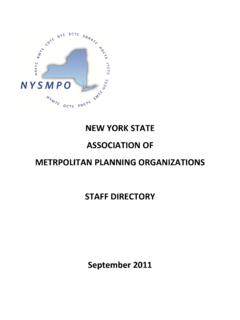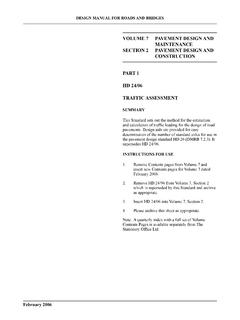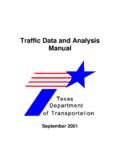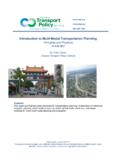Transcription of FACT SHEET: Timing Traffic Signals to …
1 Timing Traffic Signals to accommodate PedestriansFACT primary purpose of Traffic Signals is to assign right-of-way to travelers through an intersection, thereby improving their safety. When thinking only of cars, optimizing signal Timing becomes relatively straightforward, using the methodologies of the Highway Capacity Manual through available software applications. However, the Traffic engineer must recognize that the most vulnerable traveler is the pedestrian . There is a limit to how fast people can walk to reach the far curb or median refuge island. This is especially true of senior citizens, children, and those with mobility or visual impairments. To properly time Traffic Signals for pedestrians, the engineer must consider pedestrian counts as well as vehicle counts, and survey the area near the intersection.
2 Are there land uses that generate pedestrians of special concern, like housing for seniors and/or persons with disabilities, a senior center, a school, or a transit station or stop?Manual of Uniform Traffic Control Devices (MUTCD)The Manual of Uniform Traffic Control Devices (MUTCD) is the proper reference for Timing Traffic Signals . The Federal Highway Association (FHWA) Traffic signal Timing Manual is also helpful in understanding these PracticeThe MUTCD specifies use of a walking speed of feet/second to calculate pedestrian crossing time. The MUTCD also states that a slower walking speed can be used if people FACT SHEETT iming Traffic Signals to accommodate Pedestrianswho walk more slowly or use wheelchairs routinely use the crosswalk . This involves engineering judgment. Current research suggests that if there are more than 20% elderly people in the pedestrian stream, a slower walking speed of feet/second should be used to calculate pedestrian crossing these definitions of the components of pedestrian signal Timing :Walk Interval: The walk interval should provide pedestrians adequate time to perceive the WALK indication and depart the curb before the pedestrian clearance interval begins.
3 It should be long enough to allow a pedestrian that has pushed the pedestrian push button to enter the crosswalk. pedestrian Clearance (or Change) Interval:The pedestrian clearance interval follows the walk interval. pedestrian clearance time is computed as the crossing distance divided by the walking speed. When the pedestrian clearance interval begins, pedestrians should either complete their crossing if already in the intersection or refrain from entering the intersection until the next pedestrian walk interval is displayed. FHWA Traffic signal Timing ManualTiming Traffic Signals to accommodate PedestriansFACT Walk Interval should be at least 7 seconds, although the MUTCD allows If pedestrian volumes and characteristics do not require a 7-second walk interval, walk intervals as short as 4 seconds may be used.
4 MUTCD 4E-06, 12 The pedestrian Clearance Time should be sufficient to allow a pedestrian crossing in the crosswalk who left the curb or shoulder at the end of the WALKING PERSON (symbolizing WALK) signal indication to travel at a walking speed of feet per second* to at least the far side of the traveled way or to a median of sufficient width for pedestrians to wait. MUTCD 4E-06, 7 *This is where a decision about using a slower walking speed affects the calculated pedestrian Buffer Interval of at least 3 seconds shall be displayed prior to the release of any conflicting vehicular movement. All pedestrian signal heads used at crosswalks where the pedestrian change interval is more than 7 seconds shall include a pedestrian change interval countdown display. MUTCD with high pedestrian volume and a high volume of conflicting turning vehicles can be a safety hazard.
5 A signal Timing technique that may be considered in that situation is a Leading pedestrian Interval. This is an extension of the All-Red clearance phase during which the WALK indication is displayed for the direction which will receive the next green phase. This allows pedestrians to proceed into the crosswalk prior to any vehicles, making them more visible to drivers. This may also be considered at suburban intersections with lower pedestrian volume, but a clear conflict with turning vehicles. If a leading pedestrian interval is used, it should be at least 3 seconds in duration and should be timed to allow pedestrians to cross at least one lane of Traffic or, in the case of a large corner radius, to travel far enough for pedestrians to establish their position ahead of the turning Traffic before the turning Traffic is released.
6 MUTCD 4E-06 22 The MUTCD further states that if a leading pedestrian interval is used, accessible pedestrian Signals should be considered. Prohibiting Right Turn on RedRemember to review the requirements for prohibiting right turn on red. As stated in the MUTCD, a No Turn on Red sign should be considered when an engineering study finds that one or more of the following conditions exists: Inadequate sight distance to vehicles approaching from the left (or right, if applicable); Geometrics or operational characteristics of the intersection that might result in unexpected conflicts; An exclusive pedestrian phase; An unacceptable number of pedestrian conflicts with right-turn-on-red maneuvers, especially involving children, older pedestrians, or persons with disabilities; More than three right-turn-on-red accidents reported in a 12-month period for the particular approach; or The skew angle of the intersecting roadways creates difficulty for drivers to see Traffic approaching from their left.
7 MUTCD, IntervalsThe above figure from the MUTCD shows the components of pedestrian signal Timing and the manner in which they may be this fact sheet addresses only Traffic signal Timing , intersection design features such as corner bulb-outs and median refuges can reduce the crossing distance, and therefore the required pedestrian clearance time, while making the intersection more pedestrian -friendly.






